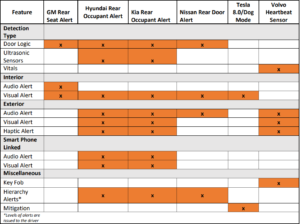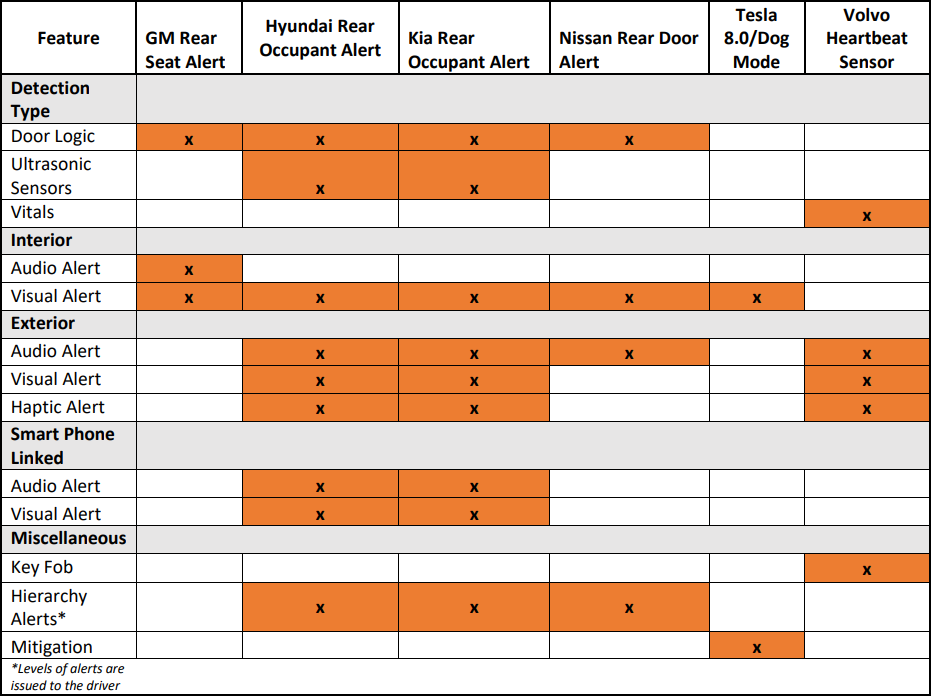Hot Cars Act introduced and passed in 2019 in the United States declares that “all new passenger motor vehicles weighing less than 10,000 pounds (4,536 kilograms) gross vehicle weight require visual and auditory alert for rear seat occupant once motor is deactivated. In addition, the bill suggests requiring systems that also detect the presence of any occupant who has entered an unoccupied vehicle independently.” According to National Highway Traffic Safety Administration (NHTSA), they have evaluated aftermarket rear seat reminder technology systems and found most of them unreliable and difficult for consumer to install on cars. There are a few different types of systems that are available at the market at this time, please see below for further explanations:
Pressure based systems: these systems use pressure sensitive pads to indicate that a baby or young toddler is seated in a car seat. Once the pressure is indicated, a signal is then sent to driver’s smart phone through Bluetooth with an alert if the driver goes too far away from the baby seat. Current available systems are: Never4GetUs, Driver’s Little Helper, and Sense A Life.
Child Restraint based technology systems: These systems use clips or sensors that are clipped onto or built into child restraints that is synchronized with key via Bluetooth onto driver’s smartphone. If the driver leaves the car and goes beyond a predetermined distance, an alert will be sent to the smartphone. Such available systems are: iAlert True Fit and ChildMinder SoftClip.
Vehicle based technology systems (OEM): These systems are pre-installed at the time of purchased, or can be installed at a dealer later on if the driver decided to not to at time of purchase. A few car brands have these systems available during this time. Such available systems are: General Motors (GM) Rear Seat Reminder (RSR), Hyundai Rear Occupant Alert (ROA), Kia Rear Occupant Alert (ROA), Nissan Rear Door Alert (RDA), Tesla Dog Mode, and Volvo Heartbeat Sensor. Please see the chart below for additional explanation.
At this time, there are certain limitations on these few types of systems limiting or reducing PVH scenarios. Please see the concerns below for further clarification:
Only one system below (Tesla) seemed to notify the driver of child’s gained access without driver’s knowledge, while most of the systems do not send any notification or alerts to the driver.
Most of these systems do not offer more than one way to detect a rear occupant (including elderly or even a pet) and multiple or redundant systems to notify driver or other emergency contacts.
Some only have one alert type and a driver may miss an alert if situations arise which may include noisy surroundings, other similar alerts from other cars such as doors ajar, keys left in vehicle, etc.
Some of the alerts are optional and could be turned off, which could be missed by the driver if the driver is distracted.
Some of the systems malfunctioned and sent false alerts which may cause unwanted or unwarranted awkward situations (GM Rear Seat Alert).
Some systems detect baby’s or young toddler’s movement, but when they are at idle or resting, the system has trouble detecting them (Hyundai’s ROA).
According to studies, PVH systems should cover all three scenarios: gain access without parental knowledge, being intentionally left in vehicle, and being unintentionally left in vehicle. In addition, they should be easy to use, reduce false starts, redundant alerts or emergency contacts, incorporate multiple detection methods, and possible integration to existing vehicle system’s such as Onstar, and other similar systems that may be available at this time.
There is no such thing as enough when it comes to our baby or young toddler’s life. We need to come up with a system that can satisfy almost all of the scenarios. Let us try to come up with a system that goes beyond what is available now. This is why Baby Car Safe is created, and this is why we do what we do.
Picture on the right shows graph where x indicates vehicle is equipped with system.
Text:


